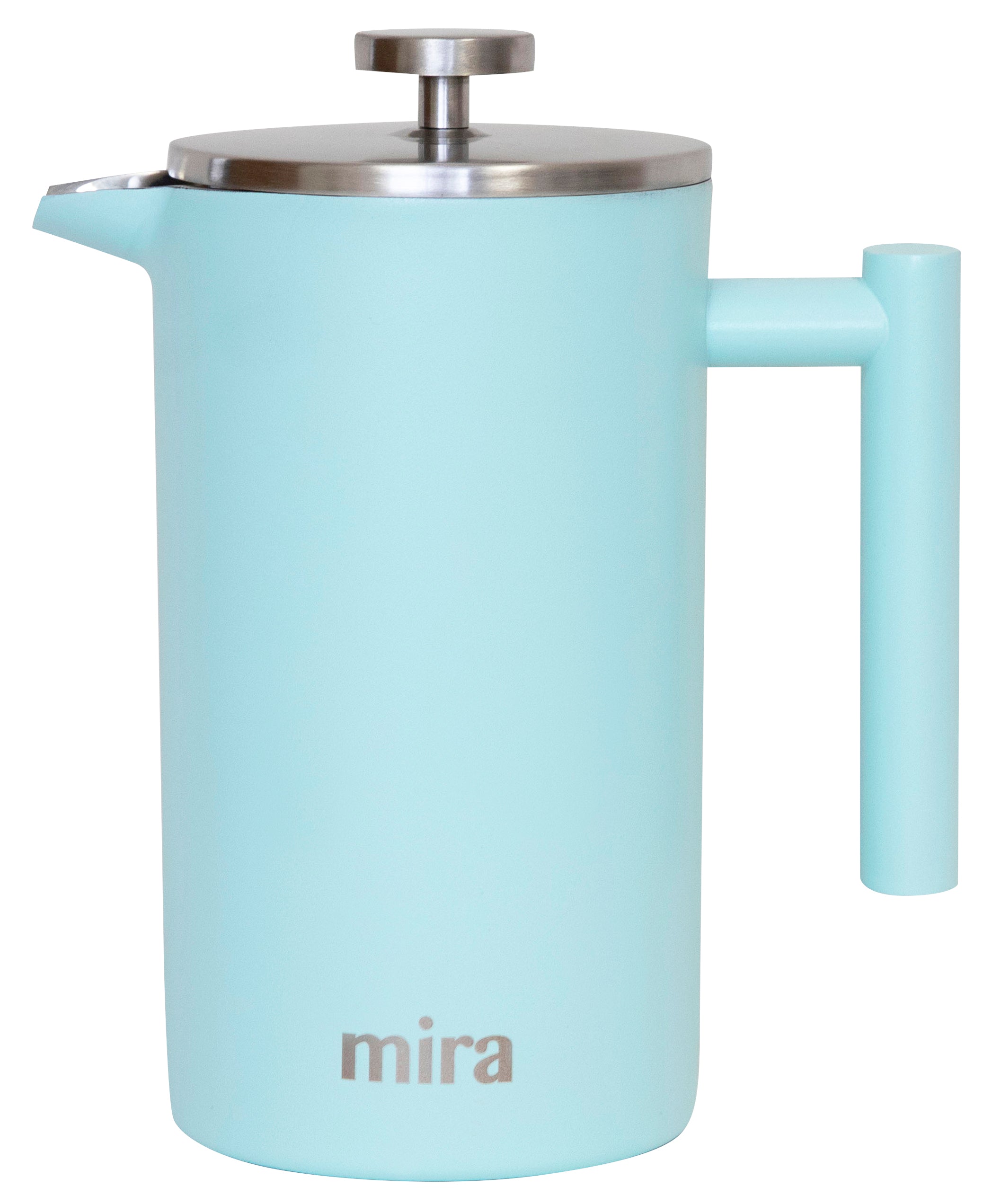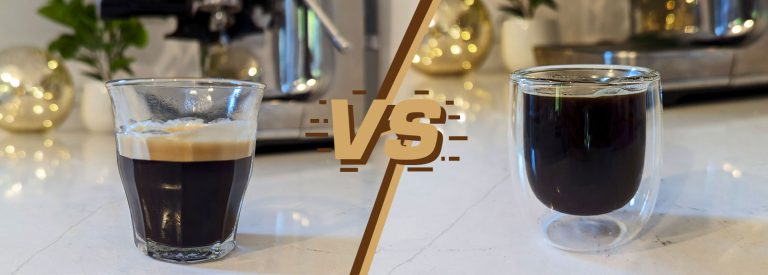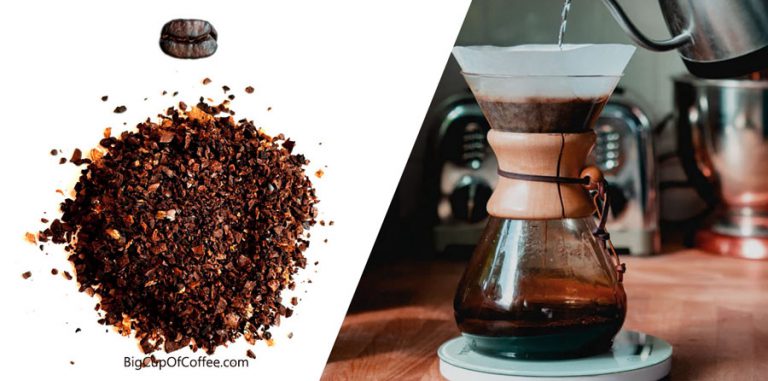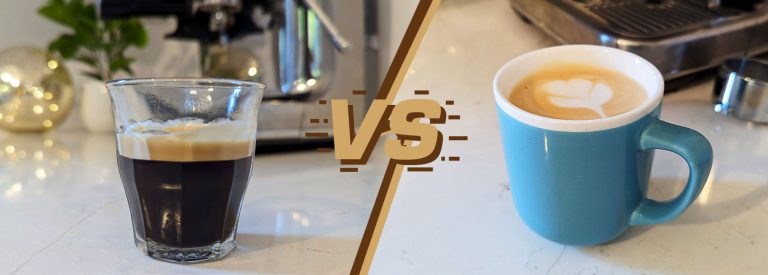Chemex vs French Press: Which One Can Make the Perfect Brew?
This review of manual coffee brewing tools is interesting because it’s Chemex vs French Press. Can either brew a perfect cup of coffee? Is Chemex better? Is it just fancy drip coffee? What’s more perfect than french press? This is a reminder that you have complete control over your favorite coffee preparation. We’ll show you some tips, the differences, and how you can get started preparing your own chemex or french press coffee.
What is Chemex?
The Chemex coffee maker is made out of glass and resembles an hourglass with its conical funnel-like neck. It has a heat proof wooden collar wrapped around its neck so you can handle it with ease as you pour coffee to your cup. You can split the wooden collar into two to fit it around the glass’ neck and hold it in place by a tied leather thong.
Among the 300 patents developed by the eccentric American chemist Dr. Peter Schlumbohm, the CHEMEX coffee maker, invented in 1941 by far, is the most successful patent. The Chemex coffee maker embodies the design of beauty with full functionality. To realize Chemex’s capability as the perfect device for brewing coffee, he studied the science behind coffee flavor and caffeine extraction.
This knowledge resulted in the invention of the double-bonded Chemex paper filters.
Pros
- The coffee is sediment-free.
The Chemex filters prevent coffee grounds from passing through. Thus you can drink a clean and bright coffee with this brewing pot. Likewise, it prevents the coffee from getting bitter because the paper filters also capture the coffee oils.
- The Chemex pot is simple to clean.
Unlike French Press, where you need to scrape the coffee grounds from the bottom, you can wash Chemex the way you wash your drinking glasses. There’s no need to scrape the grounds because all of it is stuck in the Chemex filters, which you can throw away or use as plant fertilizer.
- You can brew more coffee.
If you are serving a group with your favorite beans, you can use Chemex to brew coffee. You can brew 3 to 6 cups of coffee, depending on the size of Chemex you’ll use.
- Chemex allows you to have full control over the brew.
This brewing device empowers you to become the barista at home. You can tweak the ratios between the coffee grounds and water when you use Chemex.
- You can make a cold brew with Chemex.
You can beat the summer heat with coffee as Chemex lets you prepare the cold brew. All you need is to tweak the ratios of your coffee grounds and water to make your cold brew tasty. If you want to learn the best cold brew coffee, you can use it for your Chemex. We’ve listed tons of coffee blends in our cold brew review.
The Chemex coffeemaker is made from non-porous Borosilicate glass, ensuring it does not absorb odors or chemical residues, thus delivering a pure flavor experience. It features a simple and timeless design, with customizable options including painted wooden collars in various colors and different rawhide combinations. This coffeemaker is designed for purity and quality, using high-quality glass similar to lab ware, and is paired with Chemex Bonded filters to eliminate unwanted elements like fats, bitterness, and sediments from the coffee.
Cons
- The Chemex can be a bit expensive because of paper filters.
Without the Chemex filters, you won’t be able to brew a decent coffee. These paper filters are different from ordinary filters you usually use with Pour-over brewers. The filters are double-bonded and are designed to capture the coffee grounds and oils.
These pre-folded, cone-shaped Chemex filters not only fit most cone-shaped coffeemakers but also remove undesirable elements and are compostable. The filters feature a thicker fiber design and undergo an oxygen cleansing process to prevent imparting any chemical taste, accommodating all types of roasts and even tea.
- Chemex requires your involvement in the brewing process.
Unlike French Presses, where you can step away for a few minutes while the hot water extracts the coffee beans, the Chemex needs you to do the first and second pour. The water has to be added in a circular and swirling motion to ensure that the entire coffee grounds will be extracted evenly.
How to Brew Coffee using Chemex
To make coffee with Chemex, these are the most straightforward procedures we can share:
- Add a medium or coarse ground coffee in the paper filter designed explicitly for Chemex use.
- Soak the coffee grounds with hot water (the temperature must be around 195 to 200F) and allow it to bloom for about 30 seconds.
- Pour the rest of the water slowly in a circular, swirling motion to evenly wet the coffee grounds.
- The entire process takes less than 4 minutes to complete the coffee bean extraction.
What is the French Press?
Two French inventors patented the first French Press coffee maker in 1852. It was further improved and patented by a Milanese designer, Attilio Calimani in 1928, in which his design resembles the current design of French Presses today. Arguably, the most famous style was the patented design in 1958 of a Swiss man named Faliero Bondanini, known in France as Chambord.
The French Press uses pressure to force coffee grounds to the bottom of the cylindrical carafe. As the plunger goes down, the extracted coffee goes up. Using French Presses requires great attention because miscalculations can result in over-extracted coffee with an awful bitter taste. Likewise, it involves boiled water, so the presence of the mind is a must.
Pros
French Press has valuable points that make it a favorite brewer to many coffee purists and casual coffee drinkers. These are:
- Prepares aromatic and flavorful coffee
The steeping of coffee beans using a French Press allows the water to break down parts of the coffee beans. It optimizes the extraction of oils, flavors, and nuances of the coffee beans. After four minutes, the ground beans are forced to the bottom as you push the plunger down while the concentrated coffee rich in flavor and aroma goes to the top.
- Allows you to brew more coffee
French Press coffee makers can prepare big servings of coffee. 12-cup hot water and 48 oz of coffee grounds can brew pressed coffee for eight people in one brewing cycle. If you drink coffee to get a boost for a productive day, you can have a lot of refills of your favorite beans.
- French Press has integrated metal mesh filters.
French Press doesn’t use paper filters to avoid grounds getting into your cup. You no longer need to buy a stash of paper filters because the integrated metal mesh filter will steep the coffee grounds to extract flavor and nuances. This metal mesh allows the coffee oils and other compounds to pass through while keeping the grounds at the bottom. Thus, you extract a full-bodied coffee.
- French Press is inexpensive and comes in varying types.
Brewing coffee with French Press will not cost you a fortune. It doesn’t require any fancy brewing accessories to prepare coffee. Cooking equipment to boil water and a burr grinder to grind the beans are all you need. There are French Presses sold in the market according to your needs.
There’s an all-in-one French Press travel mug for a frequent traveler that you can place in your car’s drink holder. BPA-free French Presses with insulated sleeves are recommended for campers. Likewise, you can buy the usual glass French Press for office coffee break while other types are made of stainless steel that can hold heat and won’t break.
This French press coffee maker is made of durable 18/10 stainless steel, offering unbreakable, shatterproof qualities and insulated to keep beverages hot. It features a quick and easy brewing process, with an ultra-fine mesh filter that enhances flavor and aroma, and is dishwasher-safe and easy to clean. Versatile and portable, this French press is suitable for making various types of coffee and tea, and its lightweight, compact design makes it ideal for travel.
Cons
Despite the positive feedback given by many coffee lovers who use French Press to make coffee, they also shared some of its setbacks:
- It doesn’t brew coffee in less than a minute
The French Press is not for impatient, on-the-go coffee drinkers. Brewing coffee with French Press requires timing and great attention because one mistake can result in a bad tasting coffee.
- You have to check the hot water temperature.
When you make pressed coffee, it’s vital to boil the water separately and check the water’s temperature. Water that is too hot can result in over-extraction, while lukewarm water can result in under extraction and a bland coffee taste.
How to Brew Coffee Using French Press?
- For starters, you can start with the coffee to water ratio of about one tablespoon of coffee grounds (7 grams of coffee) to 1 cup of water (4 ounces of water). If you want a full-bodied coffee, increase the amount of coffee with another one tablespoon. If you want a light and flavorful coffee, use less coffee.
- Warm-up your French Press and coffee mug with hot water to avoid shifting temperatures that can affect the coffee bean’s extraction.
- Place the right amount of coffee grounds into your French Press and flatten the bed.
- Measure the temperature of the hot water first before you pour it into the French Press. The temperature should be between 195 and 205 degrees Fahrenheit.
- Stir the mixture to get all the grounds soaked.
- Put the lid in place and start timing the brewing cycle. You can make a less bitter coffee if you use boiled water with less temperature. It helps in lessening your brew time between 2 and 3 minutes. Likewise, you can make a balanced coffee by enabling the coffee extraction for at least 3 or 4 minutes. If you brew it for more than 5 minutes, the coffee will taste awful and bitter.
- Slowly push the plunger to the bottom to stop the coffee extraction.
- Once the plunger reaches the bottom, gradually pour the French press coffee gently to a carafe or your mug.
Chemex vs French Press
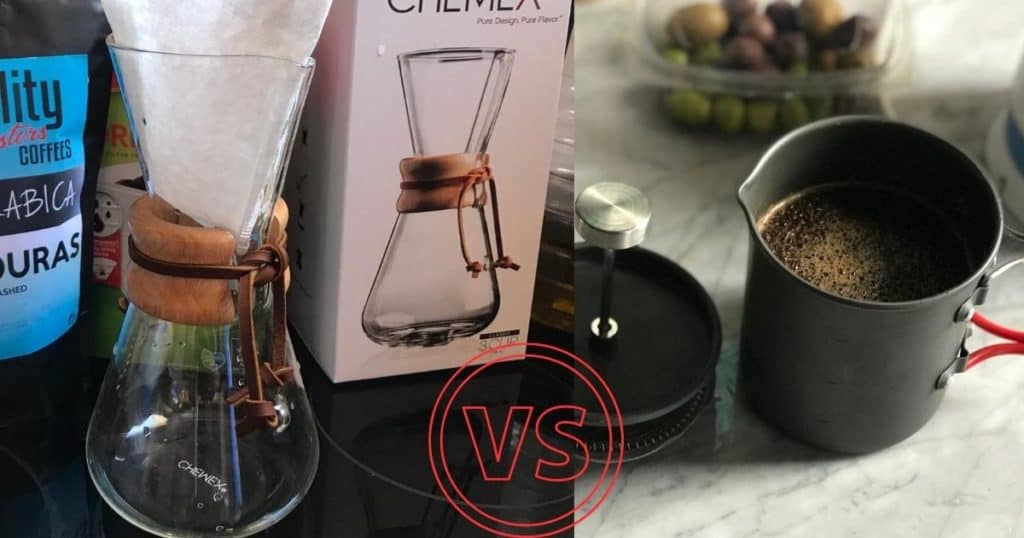
To get a better picture of this Chemex vs. French Press review, we’ve summarized the essential points to consider when using these brewing devices to make delicious coffee.
Design
Chemex is usually made of glass and resembles an hourglass with a wooden collar wrapped around its neck for easy handling. The French Press resembles the look of a pitcher. The cylindrical carafe includes a plunger where the metal mesh filters are attached.
Grind
The grind size can directly affect the coffee bean’s extraction. The recommended grind size is a coarse grind to make a French Press coffee. This type of grind slows down the extraction rate. Likewise, it helps in preventing over-extraction, which makes the coffee taste awful and bitter.
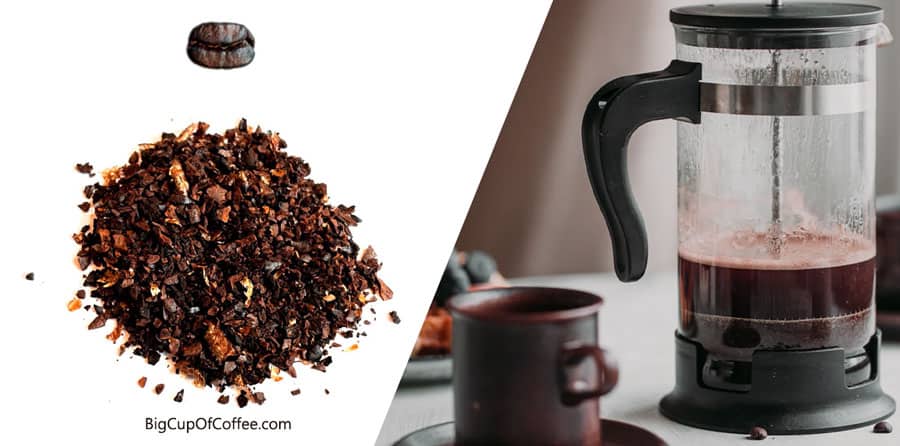
Coarse grind coffee beans also won’t get stuck in the filter or push through the mesh filter. If you use finely grounded coffee, you’d likely to encounter the following problems:
- Pressing the filter down would be difficult. If you force the plunger down, it can result in breakage of glass French Presses or coffee spillage.
- Coffee grinds might pass through the mesh filter.
- Coffee grinds that have managed to pass through can make the coffee bitter due to over-extraction.
If you are using Chemex to brew coffee, we recommend using light and medium roast ground to medium-coarse grind size. It will be filtered by Chemex filters, which are thicker than regular paper filters and are designed to fit the mouth and the neck of the brewer.
The medium-coarse grind is an ideal grind size for Chemex because it allows balance in extraction and brewing time. It enables a steady flow rate that takes the brew time to complete between 3 to 4 minutes.

Time to Brew
Using a French Press, you can make coffee for about 5 minutes. Once you have added the hot water to the carafe, you can step away while waiting for the coffee extract.
With Chemex, you can make coffee in less than 4 minutes. Yet, you have to be there the whole time you brew the coffee beans as you have to manually control the pouring of water over the coffee beans in the paper filter.
Taste Differences
French press is not only famous because of its classic aesthetic look but also with the satisfying and rich coffee it can make. The texture of the French press coffee differs from the Chemex coffee. The coffee exhibits a thick and velvety mouthfeel because of its contact with the grounds from the beginning to the end of the brewing cycle.
On the other hand, Chemex coffee produces a cleaner and brighter coffee with no signs of coffee grinds. It uses a double-bonded paper filter to prevent grinds from passing through. Yet, the filters’ downside is that coffee oils that bear the coffee nuances are also trapped in the filter.
Amount of Coffee Made
Chemex can make 3 to 6 cups of coffee, depending on the size of the pot. The French Press can prepare up to 8 cups of coffee in one brewing cycle.
Cleaning
Cleaning the Chemex is like cleaning a piece of laboratory equipment after use. Just throw away the filter and wash the pot with liquid soap and water. After drying it up with a clean cloth, you can store it in your cabinet and call it a day.
On the other hand, when you clean the French Press, you have to scrape out the coffee grounds stuck at the bottom diligently, it will be extracted the next time you use it to brew coffee.
Filters
Chemex uses specialized, double-bonded Chemex filters that capture the grounds and oils effectively. The French Press has an integrated metal mesh filter that is attached to the plunger.
However, some people have an issue with the lack of a fine filter on a French press, as it allows the organic compounds called diterpenes to pass through, which may raise cholesterol and risk of heart disease when consumed regularly and in large amounts.
But if you consume French press coffee in moderate amounts, you should have no issues with the health implications of diterpenes. You can read more about it in our detailed article about diterpenes in French press coffee.
Our Verdict: Who Wins?
Our French Press vs Chemex review enables us to differentiate the quality of brew and its processes to make that “perfect brew.” Chemex is specifically designed for people who want to enjoy their coffee with no jitters to worry about because of the strict extraction and filtering that Chemex filters do.
If you want thick and strong coffee to get you through the day, the French Press is the device for you. The French Press extracts everything that the coffee beans can offer – oils, flavors, and nuances – without limit. Meaning, you can taste the coffee bean extract in its purest and most concentrated form.
So whether you choose Chemex or French Press for your at-home brewing of the perfect cup of coffee, the real winner is you.
Have you tried using any of these brewing methods? Which of these brewing methods enables you to make a cup of coffee that you love? Please share with us your Chemex and French Press thoughts at the comments below.




